Men’s Hair Loss & Male Pattern Baldness
Male pattern baldness (androgenetic alopecia) and other types of hair loss in men, like telogen effluvium and alopecia areata, are very common. According to the American Hair Loss Association, over 65% of men will experience hair loss at some point in their lives. The earlier you start hair loss treatment, the more effective it is in promoting new hair growth and preventing further loss. As soon as you notice signs of hair thinning or if you have a family history of male pattern baldness, consult an experienced board-certified dermatologist, such as Dr. Green in NYC. At her private dermatology office on Manhattan’s Upper East Side, Dr. Green develops personalized hair loss treatment plans for each patient, combining topical serums, oral medications, and in-office treatments tailored to their specific type of hair loss.
Some of the most popular hair loss treatments include topical minoxidil solution, oral minoxidil, finasteride, dutasteride, platelet-rich plasma injections, Keravive scalp treatment, corticosteroid injections, and hair transplants. The treatment plan recommended for you should be determined by an expert, such as Dr. Green, based on a professional assessment of your condition, medical and family history, and the specific type of hair loss you have. Male pattern baldness occurs when the hair follicles in the scalp shrink, leading to a halt in hair growth. This type of hair loss usually follows a predictable pattern, with a receding hairline and hair loss on the top of the head. Telogen Effluvium is a temporary form of hair loss that is generally stress-induced and causes diffuse thinning of the hair. Alopecia areata is an autoimmune disorder where the immune system attacks the hair follicles in the scalp, resulting in patchy hair loss. Dr. Green is an expert in hair loss and will work with you to ensure your treatment plan is tailored to your individual needs.
Dr. Michele Green is a globally recognized, board-certified dermatologist with over 25 years of experience diagnosing and treating various types of hair loss. Dr. Green adopts a holistic approach to hair regrowth, tailoring each patient’s treatment plan to meet their unique needs and goals. Consistently named one of New York’s top dermatologists by Castle Connolly, New York Magazine, and Super Doctors, she is celebrated for her dedication and expertise. Dr. Green offers a broad array of cosmetic and medical treatments to stimulate hair growth and prevent further loss. Dr. Green was among the first dermatologists in NYC to incorporate Platelet-Rich Plasma (PRP) therapy into her Upper East Side practice, helping many men and women achieve thicker, fuller, healthier hair that lasts.
What is Male Pattern Baldness or Androgenetic Alopecia?
Male pattern baldness, also called androgenic alopecia, is the most common type of hair loss in men as they age. It is a gradual process that affects about 50 million men in the United States. Signs of male pattern baldness can appear as early as the teenage years, and more than half of all men over 50 experience some degree of it. The classification system for this pattern of hair loss is known as the Hamilton-Norwood scale, which comprises seven stages. Stage 1 is the least severe, with no noticeable hair loss. Stage 7 is the most severe, characterized by a mostly bald scalp. In stage 7, a band of thin, fine hair may form around the sides of the head. The Norwood scale enables dermatologists to assess the severity and progression of a patient’s hair loss, and it also suggests the most suitable treatment options.
Male androgenetic alopecia results from a mix of various risk factors that are still being researched. However, it is known that in men, this type of hair loss is linked to genetics and male hormones called androgens. It often begins as hair loss above the temples and at the vertex and crown of the scalp. Over time, the receding hairline takes on a distinctive “M” shape. This pattern of thinning continues until the hair recession and bald spot meet, creating a “U”-shaped pattern of hair in the back and sides of the head, eventually leading to partial or complete hair loss.
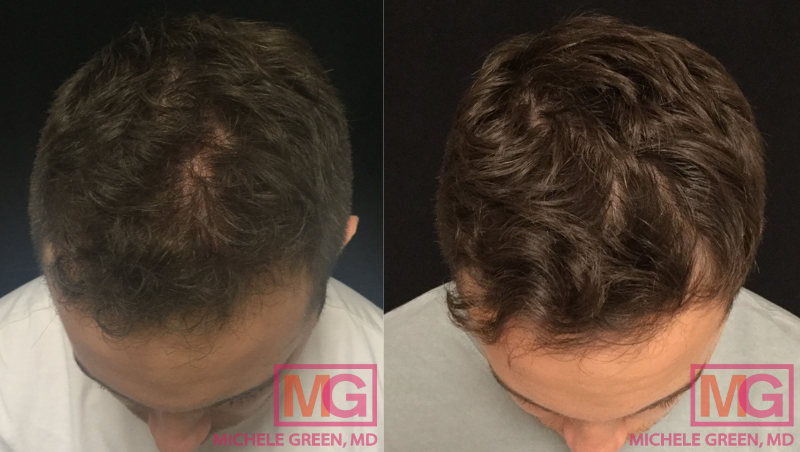
6 Months after PRP hair treatment
What causes male pattern baldness?
Male pattern baldness can affect all men, with the likelihood increasing with age. The exact cause of male pattern baldness is still unknown and remains under research. However, it has been found that this type of hair loss in men is linked to a combination of genetics and male hormones called androgens. Men with a family history of hair loss, especially among male relatives, are more likely to develop male pattern baldness. Men with androgenic alopecia often have increased sensitivity to dihydrotestosterone (DHT), a male hormone that plays a key role in developing male sex traits, including facial and body hair. In genetically predisposed adults, DHT can attach to androgen receptors in the scalp’s hair follicles, causing the follicles to shrink. This follicular miniaturization results in weaker hair that has a shorter lifespan. Eventually, the hair follicles stop producing new hair altogether.
Other common types of hair loss in men
While male pattern baldness is the most common cause of hair loss in men, other types of hair loss can also affect them. Telogen effluvium is another common type of hair loss in men, typically caused by illness or stress. Autoimmune disorders, such as alopecia areata, lichen planus, and lupus, are also associated with different kinds of hair loss in men.
Telogen Effluvium
Telogen effluvium (TE) is a common type of hair loss that happens when many hairs in the growth phase enter the resting or telogen phase. Unlike the slow progress of male pattern baldness, TE causes rapid hair loss over a short time. Hair grows in four main phases: the anagen (growth) phase, the catagen (transition) phase, the telogen (rest) phase, and the exogen (shedding) phase. Usually, most hair is in the anagen or growth phase. However, in telogen effluvium, most hair follicles switch to the telogen phase, leading to hair loss.
Telogen effluvium is usually temporary and can be caused by factors such as emotional or psychological stress, diet, pregnancy, illness, surgery, hormone changes, and some medications. For instance, a stressful event like the death of a loved one or a car accident may lead to increased hair loss in the following months. Researchers have also connected COVID-19 to this type of hair loss (https://pmc.ncbi.nlm.nih.gov/articles/PMC9262270/). Certain nutritional deficiencies, like iron and zinc, can also play a role in TE. Some medications, such as antidepressants, might also induce telogen effluvium. Additionally, TE can be a sign of another medical condition, such as thyroid disease.
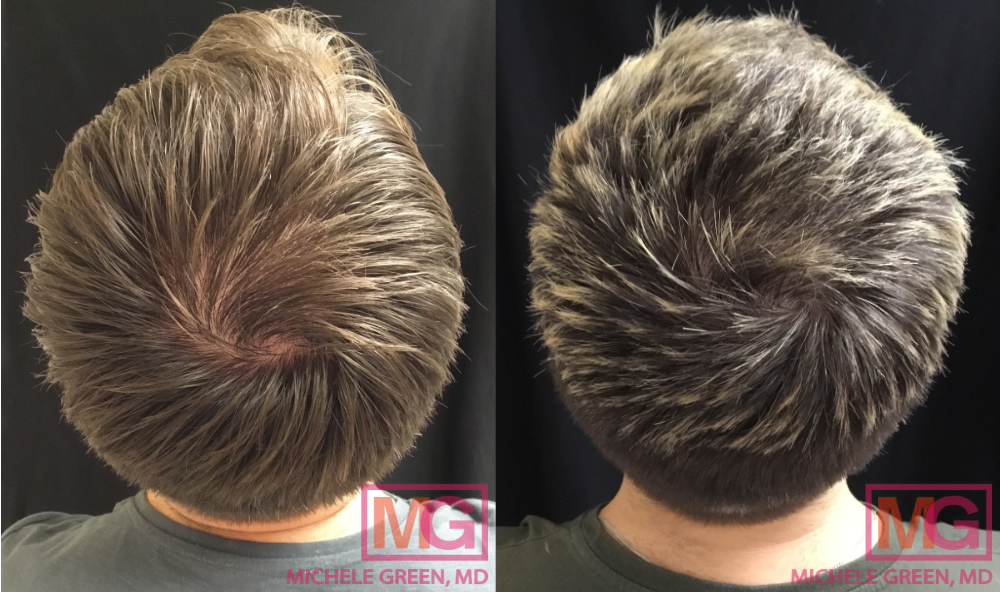
6 Months after PRP hair treatment
Alopecia Areata
Alopecia areata is an autoimmune disorder that causes hair loss in small patches. This type of hair loss happens when the immune system attacks hair follicles in areas such as the scalp, beard area, arms, and legs. Another sign of alopecia areata is brittle, pitted nails. The condition can be unpredictable and can start at any age. About half of those with this condition see hair regrowth within 12 months without treatment. However, most individuals will experience more than one episode of hair loss during their lifetime. The exact cause of alopecia areata remains unknown. Still, having a family history increases the risk. You are also more likely to develop alopecia areata if you have other medical conditions like asthma, thyroid disease, or vitiligo.
How to treat male pattern hair loss
The earlier you start hair loss treatment, the more effective it is at preventing further hair loss and encouraging new hair growth. As soon as you notice hair thinning or loss, schedule a consultation with an experienced, board-certified dermatologist like Dr. Michele Green in NYC. Dr. Green customizes each patient’s hair loss treatment plan to fit their unique needs. When you see Dr. Green at her private dermatology office in Manhattan’s Upper East Side, she will gather a detailed medical and family history, physically examine the affected areas, and review any previous hair loss treatments you may have tried. Then, she will suggest a personalized combination of topical treatments, oral medications or supplements, and in-office procedures to help you stop hair loss and achieve thicker, healthier, fuller hair.
Finasteride
Finasteride is an FDA-approved oral prescription medication used to treat male pattern baldness. It is one of the most reliable and effective treatment options for hair loss in adult males. It is a 5-alpha-reductase inhibitor and an antiandrogen that blocks the conversion of testosterone into dihydrotestosterone (DHT), leading to lower DHT levels. Reducing DHT can slow the shrinking of hair follicles. Many men who take finasteride notice improvements after three to four months of regular use, although results may take up to a year to be fully evident. Finasteride is often combined with topical or oral minoxidil, as studies have shown that this combination is more effective than either treatment alone in stimulating hair growth. A disclaimer about finasteride is that it can rarely cause adverse effects, including erectile dysfunction and reports of depression, which usually resolve within two weeks after discontinuing the medication. Finasteride is also used to treat men with benign prostatic hyperplasia symptoms and to reduce the risk of prostate cancer.
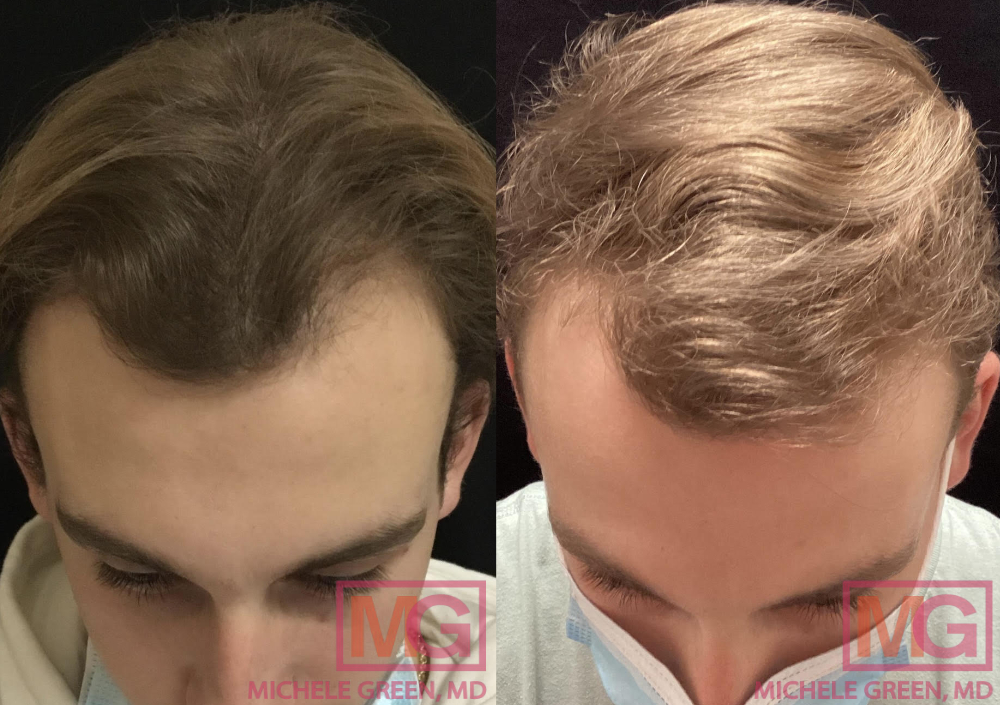
3 PRP treatment sessions, 4 months apart
Dutasteride
Dutasteride is an oral prescription medication commonly known by its brand name, Avodart. Like finasteride, it is a 5-alpha-reductase inhibitor that blocks the conversion of testosterone into DHT, a hormone linked to male pattern baldness and benign prostatic hyperplasia (BPH). While finasteride only inhibits the type 2 form of 5-alpha-reductase, dutasteride inhibits both types 1 and 2. Systematic reviews of dutasteride for hair loss treatment have shown that it is more effective than finasteride in treating hair loss. However, both medications are effective options for managing male pattern baldness. It can take 3-6 months or longer to notice visible results from using dutasteride. Side effects of dutasteride are rare and similar to those of finasteride.
Although studies with dutasteride have shown promising results in reducing hair loss in male pattern baldness, it is not currently approved by the FDA for treating hair loss in men. The only medications approved by the FDA for male pattern hair loss are finasteride and topical minoxidil. However, dermatologists like Dr. Green may prescribe dutasteride if they determine it is medically appropriate for their patients.
Topical Hair Loss Treatments
Topical minoxidil, commonly known as Rogaine, is an FDA-approved, over-the-counter treatment for hair loss and thinning. It comes as a topical liquid solution or foam that is applied directly to the affected areas of the scalp once or twice daily. Minoxidil shortens the telogen phase of the hair growth cycle, encouraging hair to enter the active anagen phase. Like other hair loss treatments, it takes several months to observe noticeable new hair growth with topical minoxidil. Over time, minoxidil enhances the thickness, density, and overall appearance of your hair.
From Dr. Green’s proprietary line of products, MGSKINLABs, Inc., the Male Hair Serum contains 7% minoxidil and 0.1% topical finasteride. A recent review in the Journal of Cosmetic Dermatology showed that combining topical minoxidil and finasteride improves hair regrowth results. Additionally, many patients prefer using topical finasteride to avoid potential systemic side effects linked to oral finasteride. Dr. Green’s hair serum is one of the few products on the market that combines both topical minoxidil and finasteride to offer an effective formulation for hair restoration.
Oral Minoxidil
Oral minoxidil is an FDA-approved treatment for hypertension but has also been shown to stimulate new hair growth. Low-dose oral minoxidil is an “off-label” option for several types of hair loss, including male pattern hair loss, female pattern hair loss, and telogen effluvium, among others. Nearly 80% of patients in clinical trials reported their hair became thicker and longer while taking oral minoxidil. Many patients prefer oral minoxidil over the topical version because it leaves no residue on the scalp, is easier to apply than the minoxidil solution, and can be safely used alongside other hair loss treatments. To start using oral minoxidil for hair loss, schedule a consultation with board-certified dermatologist Dr. Michele Green in NYC.
Platelet-rich plasma injections
Platelet-rich plasma (PRP) is a cutting-edge hair loss treatment that uses a patient’s own growth factors to promote new hair growth and stop further hair loss. The process involves drawing blood from the patient and spinning it in a centrifuge to separate the red blood cells from the plasma. The plasma contains a high concentration of platelets loaded with growth factors, including Epidermal Growth Factor to enhance cell, collagen, and blood vessel formation, Fibroblast Growth Factor-2 to support the development of specialized cells, and Insulin-like Growth Factor-1, which functions as a protein regulator for cells, among others. Dr. Green injects the PRP into areas of the scalp affected by hair thinning, which revitalizes hair follicles, boosts small blood vessel growth near the injection sites, and encourages new hair growth.
Patients with male androgenetic alopecia can benefit significantly from a series of platelet-rich plasma (PRP) injections. Clinical trials have demonstrated that PRP injections result in substantial hair regrowth, an increase in the number of hair follicles, and thicker, stronger hair strands. The American Academy of Dermatology also recognizes PRP as a safe and effective option for treating hair loss, aiding in hair regrowth. PRP can be combined with other hair loss treatments to create a comprehensive approach, resulting in thicker, fuller, and healthier hair. It remains one of the most popular hair loss therapies at Dr. Green’s private dermatology practice in NYC.
HydraFacial Keravive
The HydraFacial Keravive scalp treatment utilizes vortex technology to cleanse, exfoliate, and infuse the scalp with growth factors, thereby stimulating hair growth and enhancing overall scalp health. During the cleansing and exfoliation stage, dirt, oil, and other impurities are removed, leaving the scalp clean so the peptide complex used in the next step can be more easily absorbed. These initial steps also help increase blood flow in the scalp, allowing more nutrients and oxygen to reach the area through the blood. The next step involves infusing peptide complex solutions rich in growth factors and skin proteins to hydrate the scalp and encourage new hair growth. Keravive scalp treatments can be safely combined with other hair loss therapies, such as platelet-rich plasma injections, minoxidil, LaserCap, and other oral medications. Most patients undergo a series of at least three Keravive treatments, each spaced about one month apart, to achieve optimal hair growth results. It can take up to three months after the final treatment for the full results to be visible. Many patients receive maintenance treatments of Keravive twice a year to sustain ongoing hair growth benefits or as needed to support scalp health.
Hair Transplant Surgery
When it comes to hair loss treatments, some patients may opt for surgical options to achieve a full, healthy head of hair. Hair restoration procedures, such as hair transplant surgery, are typically recommended for individuals who haven’t achieved satisfactory results with more conservative methods. Hair transplants involve taking hair follicles from a “donor site” at the back of the scalp and transplanting them to the bald area or “recipient site.” The most advanced technique for hair transplant surgery is follicular extraction, where individual hair follicles are transplanted into the recipient area one at a time. This process usually lasts between 4 and 8 hours, depending on the size of the area being treated and the number of surgical assistants available. After the procedure, new hair growth typically begins within 6 to 9 months, and PRP injections, along with oral medications, are often used in conjunction with this treatment to enhance results.
Is there a way to stop male pattern baldness from developing?
Male pattern baldness, the most common cause of hair loss in men, has a genetic component and therefore cannot be completely prevented. However, it is possible to maintain thicker, fuller hair for a longer period and slow down hair thinning by utilizing treatment options such as finasteride, topical or oral minoxidil, and PRP injections. If you are a man with a family history of male-pattern baldness, you may want to consider consulting a board-certified dermatologist, like Dr. Green, for a personalized treatment plan to prevent hair loss. Adopting healthy lifestyle habits, including managing stress, getting enough sleep, and eating a balanced diet, can also help reduce the risk of other types of hair loss, such as telogen effluvium and alopecia areata. Keep in mind that alopecia areata is an autoimmune disorder that cannot be cured; it can only be managed. High-heat styling tools, like hair dryers, can damage your hair by dehydrating your hair follicles and making them more vulnerable to further harm. Additionally, avoid chemically treating or bleaching your hair. No matter the type of hair loss you’re experiencing, consulting an expert like Dr. Green is always the best first step. A tailored combination of oral medications, topical serums, and in-office treatments may be recommended based on Dr. Green’s assessment of your condition, medical and family history, and lab results.
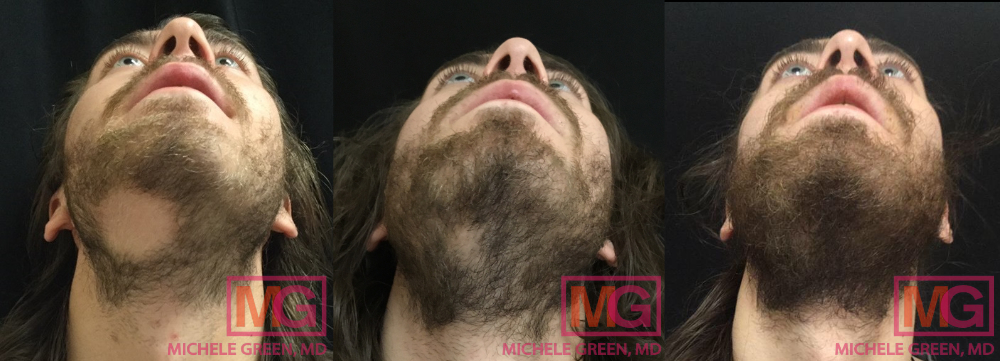
3 Months after Alopecia Areata treatment in chin area
Which hair loss treatment is best?
The best hair loss treatment plan is a personalized combination of options selected for you by an experienced, board-certified dermatologist, tailored to your medical and family history, the type of hair loss you have, and your specific needs and goals. Dr. Michele Green is an internationally renowned, board-certified dermatologist in New York City with over 25 years of experience diagnosing and treating various types of hair loss in men and women worldwide, helping them achieve thicker, healthier, and fuller hair. Some of the most popular hair loss treatments for men include platelet-rich plasma injections, Keravive scalp treatment, corticosteroid injections, topical minoxidil, oral minoxidil, finasteride, dutasteride, and Dr. Green’s hair serum for men.
How to fix male hair loss with a board-certified dermatologist
As soon as you notice signs of hair thinning or loss, schedule a consultation with an experienced, board-certified dermatologist like Dr. Michele Green. The earlier hair loss treatment begins, the more effective it is at preserving hair and preventing further loss. When you meet with Dr. Green at her private dermatology office in Manhattan’s Upper East Side neighborhood, she will gather a detailed medical, surgical, and family history and review any previous hair loss treatments you’ve tried. Dr. Green may order blood tests for additional evaluation. Based on her assessment, she might also perform a scalp biopsy and send a hair sample to an external laboratory to gather more information and develop the best hair loss treatment plan for you.
After evaluating your condition, Dr. Green will recommend a personalized combination of hair loss treatments. Hair loss is usually a complex condition, so using multiple treatment options tends to produce better results. Common treatments include topical hair serums, supplements, oral medications, and PRP injections. Dr. Green also offers a line of specially formulated topical hair serums that have helped many of her patients achieve their desired results. Based on the treatment plan you follow, you might need to return for follow-up appointments in one, three, or six months to monitor your progress. Dr. Green will work with you to create a personalized treatment schedule tailored to your specific needs.
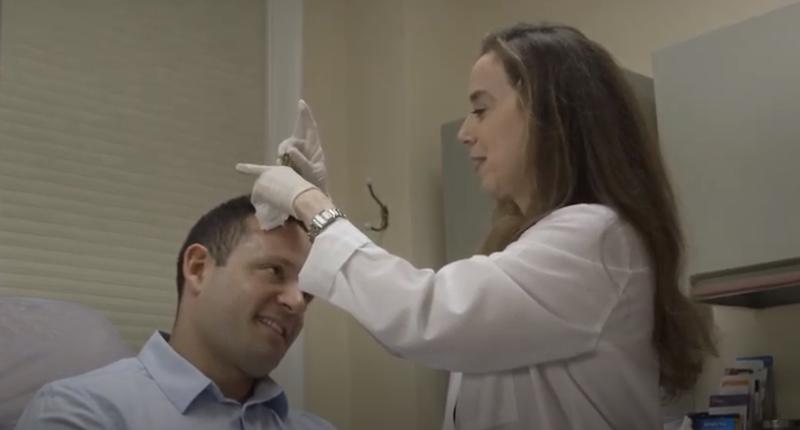
Male Pattern Baldness FAQs:
How many men experience hair loss?
Hair loss is a common condition that affects many men. In fact, hair loss in men is so widespread that by age 35, two-thirds of men experience it. Over 65% of men will face hair loss at some point in their lives. Male pattern baldness is the most common type of hair loss in men, impacting 30-50% of men by age 50 and about 50 million men in the United States. While male baldness can affect anyone assigned male at birth, men of Chinese and Japanese descent are less likely to be affected. Conversely, men of European and Afro-Caribbean descent are more prone to it. There is a hereditary aspect to male pattern hair loss, and those with a family history of the condition are more likely to develop it themselves.
Where do men’s hair genetics come from?
While the exact cause of male pattern balding remains unknown, it has been determined to have a genetic component involving multiple genes. People with a family history of male pattern baldness are more likely to develop it themselves. Male pattern baldness is also linked to a person’s natural sensitivity to the male hormone dihydrotestosterone, which can bind to the androgen receptors of scalp hair follicles, leading to hair loss.
Where does the hair loss gene come from?
One common myth is that male pattern baldness is inherited from the mother’s side, while female pattern hair loss comes from the father’s side. However, the reality is that genes for hair loss are inherited from both sides of the family; these genes can be passed down from either the mother or the father. Still, there are cosmetic and medical treatments available that can reduce or delay the effects of androgenetic alopecia by encouraging hair regrowth and preventing further loss. If you have a family history of hair loss or notice thinning hair, schedule a consultation with Dr. Green, who will work with you to develop a personalized treatment plan that includes a unique combination of topical serums, oral medications, and in-office procedures tailored to your needs.
Why do men experience hair loss?
It is common for men to lose hair due to various reasons, including genetics, abnormal hormonal levels, obesity, nutritional deficiencies, high-fat diets or dieting, illness, stress, and certain medications. According to the American Hair Loss Association, over 65% of men will experience hair loss at some point in their lives, with about 85% of men experiencing some degree of hair thinning by age 50. Excessive stress can negatively impact your body, causing hair to transition out of the growth phase and into the resting phase, which can lead to hair loss. Increased shedding is usually noticeable three months after a highly stressful event and can last up to six months. Stressful events include, but are not limited to, illness, surgery, death in the family, job loss, breakups, medication changes, and weight loss. Another factor involved in hair thinning and loss is diet. Crash diets can stress your body and harm your hair by pushing it into a state of rest, rather than encouraging growth. They can also mean your body isn’t getting all the nutrients it needs. Nutritional deficiencies in protein, iron, zinc, niacin, and fatty acids can lead to hair loss. As you reach your 40s and 50s, hair loss becomes a common issue. Additionally, poor hair care practices, like chemically treating your hair or using heat-styling tools, can cause visible damage. Overall, genetic factors remain the most common cause of hair loss.
What causes baldness at a young age?
A combination of genetic and lifestyle factors can lead to early male pattern hair loss. If you have a family history of this condition, it’s advisable to see a dermatologist early to prevent further hair loss and create an effective treatment plan. Since male pattern hair loss is primarily genetic, it can progress even with preventive measures in place. However, certain lifestyle changes can help slow down hair loss. Eating a diet rich in antioxidants can help combat oxidative stress, which can damage hair follicles. Avoid hair styling products with harsh ingredients, as they can harm your hair health. High-heat styling tools, such as hair dryers, can also damage your hair by dehydrating follicles and making them more susceptible. Additionally, steer clear of chemically treating or bleaching your hair. Routine treatments, such as minoxidil or platelet-rich plasma (PRP) injections, may help slow the progression of hair loss and promote regrowth. Consult a trusted dermatologist, such as Dr. Green, at the first sign of hair loss to increase your chances of preventing further loss and encouraging hair regrowth.
Why does men’s hair fall out?
Unfortunately, hair loss affects many men for various reasons, including genetics, hormonal imbalances, the natural aging process, or as a secondary effect of other medical conditions. Some nutritional deficiencies can cause sudden and rapid hair loss (https://doi.org/10.1007/s13555-018-0278-6). Additionally, a temporary hair loss condition called Telogen Effluvium may cause rapid shedding. Telogen Effluvium may be linked to illness, significant emotional or physical stress, sudden weight loss, or changes in diet. If you notice rapid or sudden hair loss, it’s important to see a board-certified dermatologist, such as Dr. Michele Green in New York City. Dr. Green is a globally recognized dermatology expert with over 25 years of experience offering the best non-invasive treatments, including those for hair loss.
What causes bald spots in men?
The most common cause of bald spots and patchy hair loss is a condition called alopecia areata. Alopecia areata is an autoimmune disorder that causes hair to fall out in clumps or small patches because the immune system attacks the hair follicles. It can lead to bald patches on areas where hair usually grows, such as the scalp, arms, and legs. This disorder is often unpredictable and can start at any age. Approximately half of individuals with this condition regrow their hair within 12 months without treatment; however, the regrowth cycles can be highly unpredictable for years. The exact cause of alopecia areata remains unknown, but you are more likely to develop it if someone in your family has it.
What can cause hair loss in men?
Everyone experiences a regular amount of daily hair shedding, losing between 50 and 100 hairs daily on average, which is a natural process as part of our hair’s growth cycle. Everyone experiences a normal amount of daily hair shedding, losing between 50 and 100 hairs on average each day, which is a natural part of our hair’s growth cycle. Excessive hair loss can affect anyone, whether it is permanent or temporary, and may result from hormonal changes, genetics, or aging. While hair loss can affect anyone, it is more common in men. The older you get, the more likely you are to experience some form of hair loss. Over time, as you age, your hair fibers naturally become thinner and fall out, and they do not regenerate. The natural pigment in your hair also decreases with age, making your hair lighter, finer, and grayer or whiter. If you notice increased hair thinning or have a family history of hair loss, it’s best to see a dermatologist early to prevent further hair loss and to develop a treatment plan tailored to your needs.
What causes hair loss in men’s legs?
Many patients often think of hair loss as happening only on the top of the head, but alopecia can also cause hair loss on other parts of the body. Alopecia areata universalis is an autoimmune condition that results in hair loss all over the body, including the legs. If you notice rapid hair loss on your legs, it’s best to see your healthcare provider or trusted dermatologist right away. Patches of hair loss on your legs can indicate other medical conditions, such as diabetes, thyroid problems, fungal infections, peripheral artery disease, or skin irritation from eczema, psoriasis, or other skin issues. Dr. Green has extensive knowledge about medical conditions like eczema and psoriasis that can lead to hair loss and can help you treat your skin, which may also help improve your hair.
What causes men to lose their hair?
Male pattern baldness is mainly caused by male hormones and genetics. It’s marked by a receding hairline and thinning at the crown. Each hair strand sits in a hair follicle on the scalp. Over time, these follicles shrink and become sensitive to certain male hormones, like DHT, leading to hair loss. Men with androgenic alopecia have higher levels of male hormones, such as dihydrotestosterone (DHT). DHT causes the hair follicle to shrink, weakening the hair and shortening its lifespan. Eventually, the follicles stop producing new hair.
Certain lifestyle habits, such as chronic or intense stress or illness, anxiety, rapid weight loss, and poor diet, can also trigger Certain lifestyle habits, such as chronic or intense stress or illness, anxiety, rapid weight loss, and poor diet, can also trigger male pattern hair loss. When you visit Dr. Green at her private dermatology office in NYC, she will gather a detailed medical and family history, examine your hair and scalp, and possibly order specific laboratory tests to identify the root cause of your hair loss and develop a personalized treatment plan to stimulate new hair growth and prevent further hair loss.
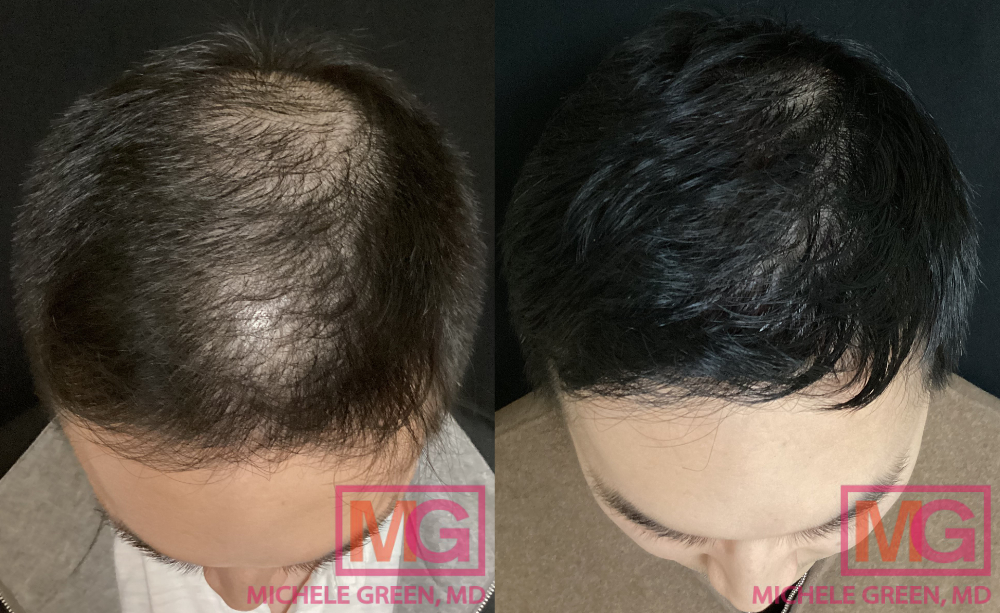
When does men’s hair start to thin?
Hair thinning and loss can begin to noticeably affect men as early as their teenage years, although the condition generally worsens with age. In fact, 1 in 4 men notice the first signs of hair thinning by age 21. By age 50, at least half of men experience some form of hair loss. While hair thinning and loss are very common in men, the most crucial step to prevent further hair loss is to schedule a consultation with an experienced, board-certified dermatologist like Dr. Michele Green as soon as you notice the initial signs. If there’s a family history of hair loss, consider booking a consultation for preventive treatment to help retain thicker, healthier, and fuller hair for longer.
What causes early hair loss in men?
Early baldness can result from factors such as restrictive diets, heredity, hormone changes, aging, certain medical conditions or medications, surgery, childbirth, illness, and smoking. However, the primary cause of hair loss is mainly genetic, and genetic thinning can begin as early as the end of puberty. Having a family history of baldness increases the chances of experiencing hair loss. The most important step if you notice early hair loss or balding is to schedule a consultation with a board-certified dermatologist, such as Dr. Green in NYC. Dr. Green has over 25 years of experience diagnosing and treating hair loss. During your consultation with Dr. Green at her private dermatology office in Manhattan’s Upper East Side, she will review your medical and family history and examine your scalp and hair to create a personalized treatment plan for hair regrowth.
What causes a receding hairline in men?
Male pattern baldness, or androgenic alopecia, is the most common cause of hair thinning or a receding hairline in men. This hereditary condition worsens with age and is marked by hair loss above the temples and at the crown and top of the scalp. Over time, the receding hairline often takes on a characteristic “M” shape, eventually leading to baldness. The most important step is to see a board-certified dermatologist, such as Dr. Michele Green in NYC, as soon as you notice hair thinning. The earlier you start treatment, the better your chances are for encouraging new hair growth and stopping further loss. Dr. Green has more than 25 years of experience helping men and women worldwide find effective non-surgical hair loss solutions and will work with you to develop a personalized plan that meets your needs.
Do any men’s hair loss products work?
Yes! Several hair loss products for men effectively stop shedding and encourage new hair growth, with 5% minoxidil being the most well-known. Saw palmetto is a common natural ingredient found in many men’s hair loss shampoos that has been proven to improve hair density with consistent use. It is always advisable to consult a board-certified dermatologist, such as Dr. Michele Green in NYC, to develop a personalized and targeted treatment plan for your hair loss. Dr. Green has the expertise and experience to guide you on the best combination of in-office procedures, specially formulated topical products, and prescriptions to meet your individual needs.
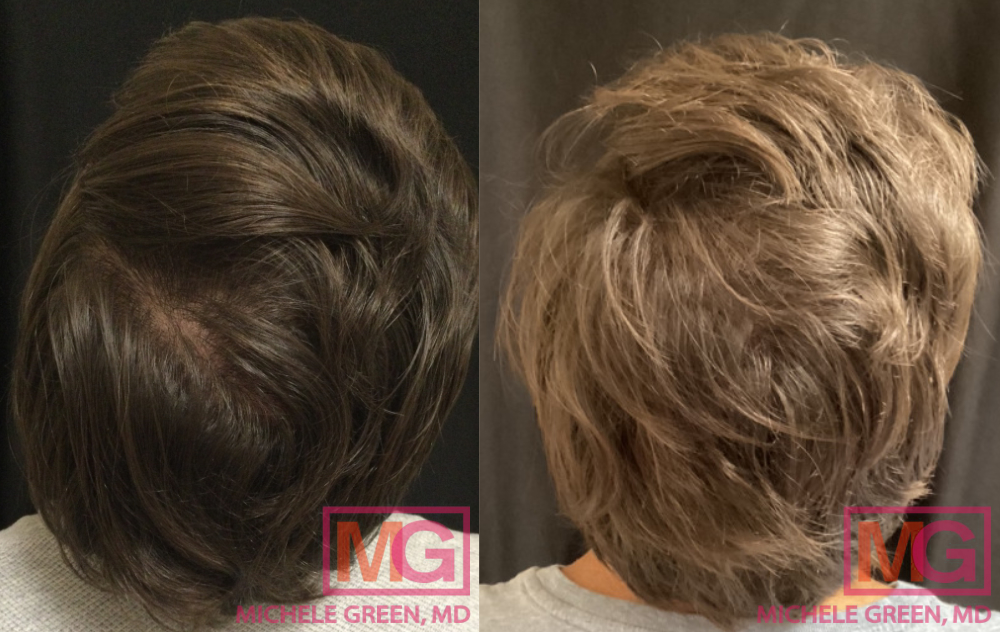
Can you stop male pattern baldness?
Various treatments can be implemented to slow the progression of male pattern baldness, encourage hair regrowth, and reduce the reliance on wigs or hairpieces. The FDA approves finasteride and topical minoxidil for treating androgenetic alopecia in men. Other common options include oral dutasteride and minoxidil, Nutrafol supplements, and Keravive scalp treatments. Platelet-rich plasma (PRP) injections are the most popular in-office treatment for hair loss. Most patients undergo a brief series of at least three PRP sessions, spaced approximately one month apart, to achieve optimal hair growth results. Many opt for regular maintenance sessions on a quarterly, biannual, or annual basis. When you receive PRP injections with Dr. Green for hair loss, she will work with you to create a personalized treatment plan tailored to your needs. The best hair loss treatment plan is always a customized combination of options chosen by an experienced, board-certified dermatologist, such as Dr. Green in NYC. Dr. Green adopts a holistic approach to hair restoration, designing each patient’s treatment plan based on their medical and family history, condition, and individual needs.
Can low testosterone cause hair loss in males?
Testosterone is a male sex hormone that gets converted into dihydrotestosterone (DHT), which can cause hair follicles to shrink. While low testosterone levels may be associated with reduced DHT production, the primary cause of hair loss is a genetic sensitivity of hair follicles to DHT. Testosterone levels might influence the growth of body and facial hair, but low levels of this male hormone do not necessarily cause hair loss. Conversely, high testosterone levels can lead to increased DHT, potentially speeding up male pattern baldness if there is a genetic predisposition. Testosterone levels do not directly cause hair loss; instead, it is the sensitivity of hair follicles to DHT that matters.
Does a lack of estrogen cause hair loss?
Lack of estrogen, a female sex hormone, can contribute to female hair loss; however, it is less of a concern in men, as estrogen is not a primary hormone in males. Men generally have lower estrogen levels than women. When estrogen and progesterone levels decline in women, hair tends to grow more slowly and becomes thinner. Lower levels of these hormones can also indicate higher circulating levels of the male hormone testosterone, which can be converted into androgens, such as DHT. These androgens shrink hair follicles, causing hair thinning and loss.
Can men’s hair regrow naturally?
Hair regrowth in men can happen naturally, depending on the type of hair loss. For instance, telogen effluvium is a temporary form of hair loss that is often caused by factors such as stress, diet, illness, surgery, hormonal changes, or certain medications. Experiencing a stressful event, such as the loss of a loved one or a car accident, can lead to increased hair loss in the months that follow. Typically, hair regrowth for telogen effluvium occurs after the triggers that caused it are removed. In contrast, for other common types of hair loss, like male pattern baldness and alopecia areata, spontaneous regrowth is unlikely. Since treatment is more effective when started early, it’s recommended to see a board-certified dermatologist like Dr. Green as soon as you notice hair loss. This enables proper evaluation and treatment to achieve optimal results.
Which vitamins and supplements are good for hair loss?
The best supplements for hair loss include biotin, iron, vitamin C, vitamin D, and zinc. If you’re deficient in any of these nutrients, you might notice hair thinning or dull hair. It’s essential to have sufficient amounts of these nutrients, but consuming too much can be detrimental. Biotin is found in egg yolks, whole grains, and animal-based foods, such as meat. Iron is present in red meat and leafy greens. Vitamin C is found in leafy greens and citrus fruits. Vitamin D can be obtained through supplements or by consuming fortified foods, such as milk. Zinc is available in beans, nuts, and shellfish. Vitamins and minerals are also added to hair loss supplements, such as Nutrafol, which Dr. Green strongly recommends for supporting healthy hair growth.
Does biotin help men’s hair loss?
Biotin is one of the most popular vitamins recommended for promoting hair growth. It naturally occurs in various foods, including eggs, oats, onions, nuts, and sweet potatoes. Biotin is essential for hair growth because it plays a vital role in the production of keratin. Keratin is the primary protein that makes up our hair and is also a key component of a strong, healthy hair shaft. Low biotin levels can result in poor hair growth and hair loss. If you have a biotin deficiency, ensure you consume a sufficient amount of biotin.
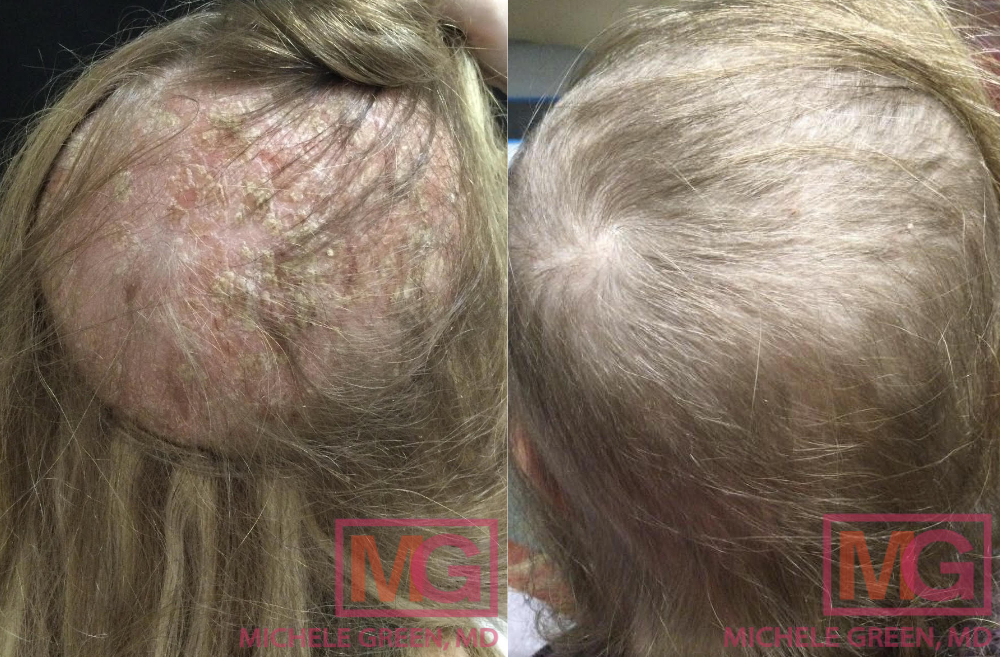
2 sessions of PRP before and after
Do lasers work for hair loss?
Yes, laser and light therapy can be beneficial in combating hair loss. The LaserCap is an FDA-approved, prescription-strength laser that’s safe, all-natural, and scientifically proven to encourage hair regrowth in both men and women. It uses Low-Level Laser Therapy (LLLT) to reactivate inactive hair follicles. This device contains no chemicals and has no side effects. It only needs thirty minutes of use, three times a week, which can be done at home or on the go. Results can be enhanced when combined with other treatments, such as minoxidil and finasteride. In one study, minoxidil, finasteride, and low-level lasers were all found to be effective in promoting hair growth (J Am Acad Dermatol).
How to stop men’s hair loss today
Hair loss can be upsetting for both men and women and often leads to feelings of self-consciousness or low self-esteem. Fortunately, numerous treatment options are available to prevent further hair loss, enhance hair thickness, and promote regrowth. A combination of therapies, including topical hair serums, oral medications, and platelet-rich plasma injections, can help control hair loss and promote new hair growth. When you notice thinning hair, the best step is to schedule a consultation with an experienced, board-certified dermatologist, such as Dr. Michele Green in New York. Whether you’re in your 20s or 60s, if you’re dealing with hair loss and thinning, Dr. Michele Green is here to assist.
Dr. Michele Green is an internationally recognized, board-certified dermatologist with over 25 years of experience providing some of the world’s most discerning individuals with top non-invasive treatments, including for hair thinning and loss. Dr. Green uses a holistic approach, tailoring each patient’s hair loss treatment plan to meet their specific needs and goals. She is consistently named one of NYC’s top dermatologists by Super Doctors, Castle Connolly, and New York Magazine for her dedication to her patients and her expertise. When you meet with Dr. Green at her private dermatology office in Manhattan’s Upper East Side, she will collaborate with you to develop a personalized hair loss treatment plan that encourages new hair growth and helps prevent future hair loss. To get started today, schedule a consultation with Dr. Green by calling the NYC office at 212-535-3088 or contacting us online.
 212-535-3088
212-535-3088